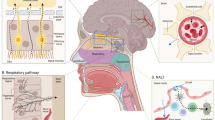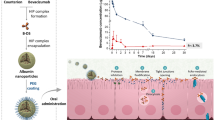Abstract
Possible risk of leukopenia is one of the drug-induced adverse effects of the atypical antipsychotic agent olanzapine (OLZ). Hence, to prevent the peripheral exposure and related side effects of the agent, the present research was aimed to prepare and investigate safety and efficacy of OLZ-loaded lipid nanocarriers in the therapy of CNS disorders via intranasal (i.n.) delivery. The OLZ-loaded nanostructured lipid carriers (NLC) and microemulsion (ME) were prepared by melt emulsification and aqueous titration methods, respectively. Optimized formulation was evaluated for the particle size, zeta potential and entrapment efficiency were found to be 88.95 ± 0.8 and 24.80 ± 0.5 nm, -22.21 ± 1.9 and − 20.84 ± 1.3 mV, and 88.94 ± 1.6 and 98.40 ± 0.95%, respectively for the two nanocarriers (NLC and ME). Alternatively, ex vivo permeation of OLZ mucoadhesive NLC (OLZ-MNLC) and OLZ mucoadhesive ME (OLZ-MME) was observed 820 ± 7.2 and 940 ± 8.9 µg/cm2, respectively. Finally, Cmax values calculated for OLZ in brain through administration of 99MTc-OLZ-MNLC (i.n.), 99MTc-OLZ-MME (i.n.) and 99MTc-OLZ-NLC (i.v.) and it was found to 9.33 ± 0.65% radioactivity/gram (RA/g), 1.06 ± 0.26% RA/g and 0.082 ± 0.004% RA/g, respectively. Therefore, 99MTc-OLZ-MNLC formulation through i.n. delivery showed superior brain uptake than OLZ-MME formulation. Simultaneously, the nanoformulations didn’t reflect any gross changes in biomarkers and hematological toxicity when compared with control. Hence, it can be inferred that the nose-to-brain delivery of OLZ-MNLC can be considered as effective and safe delivery for brain therapy.






Similar content being viewed by others
References
Alam MI, Baboota S, Ahuja A et al (2013) Intranasal infusion of nanostructured lipid carriers (NLC) containing CNS acting drug and estimation in brain and blood. Drug Deliv 20:247–251. https://doi.org/10.3109/10717544.2013.822945
Alam T, Pandit J, Vohora D et al (2015) Optimization of nanostructured lipid carriers of lamotrigine for brain delivery: in vitro characterization and in vivo efficacy in epilepsy. Expert Opin Drug Deliv 12:181–194. https://doi.org/10.1517/17425247.2014.945416
Banks WA (2012) Drug delivery to the brain in Alzheimer’s disease: Consideration of the blood–brain barrier. Adv Drug Deliv Rev 64:629–639. https://doi.org/10.1016/j.addr.2011.12.005
Beasley CM, Tollefson GD, Tran PV (1997) Safety of olanzapine. J Clin Psychiatry 58(Suppl 1):13–17
Choudhury H, Gorain B, Karmakar S et al (2014) Improvement of cellular uptake, in vitro antitumor activity and sustained release profile with increased bioavailability from a nanoemulsion platform. Int J Pharm 460:131–143. https://doi.org/10.1016/j.ijpharm.2013.10.055
Choudhury H, Gorain B, Chatterjee B et al (2017a) Pharmacokinetic and Pharmacodynamic Features of Nanoemulsion Following Oral, Intravenous, Topical and Nasal Route. Curr Pharm Des 23:2504–2531. https://doi.org/10.2174/1381612822666161201143600
Choudhury H, Gorain B, Pandey M et al (2017b) Recent Update on Nanoemulgel as Topical Drug Delivery System. J Pharm Sci 106:. https://doi.org/10.1016/j.xphs.2017.03.042
Choudhury H, Gorain B, Tekade RK et al (2017c) Safety against nephrotoxicity in paclitaxel treatment: Oral nanocarrier as an effective tool in preclinical evaluation with marked in vivo antitumor activity. Regul Toxicol Pharmacol 91:. https://doi.org/10.1016/j.yrtph.2017.10.023
Cruz M, Danoff DR (2017) Thrombocytopenia and Spontaneous Intracranial Hemorrhage After Olanzapine Therapy. J Am Osteopath Assoc 117:473. https://doi.org/10.7556/jaoa.2017.092
Fang JY, Fang CL, Liu CH, Su YH (2008) Lipid nanoparticles as vehicles for topical psoralen delivery: Solid lipid nanoparticles (SLN) versus nanostructured lipid carriers (NLC). Eur J Pharm Biopharm 70:633–640. https://doi.org/10.1016/j.ejpb.2008.05.008
Fanun M (2012) Microemulsions as delivery systems. Curr Opin Colloid Interface Sci 17:306–313. https://doi.org/10.1016/J.COCIS.2012.06.001
Ferreira M, Chaves LL, Lima SAC, Reis S (2015) Optimization of nanostructured lipid carriers loaded with methotrexate: A tool for inflammatory and cancer therapy. Int J Pharm 492:65–72. https://doi.org/10.1016/J.IJPHARM.2015.07.013
Gorain B, Choudhury H, Kundu A et al (2014) Nanoemulsion strategy for olmesartan medoxomil improves oral absorption and extended antihypertensive activity in hypertensive rats. Colloids Surf B Biointerfaces 115:286–294. https://doi.org/10.1016/j.colsurfb.2013.12.016
Gorain B, Choudhury H, Pandey M et al (2018a) Carbon nanotube scaffolds as emerging nanoplatform for myocardial tissue regeneration: a review of recent developments and therapeutic implications. Biomed Pharmacother 104:496–508. https://doi.org/10.1016/j.biopha.2018.05.066
Gorain B, Choudhury H, Pandey M et al (2018b) Dendrimers as Effective Carriers for the Treatment of Brain Tumor. In: Nanotechnology-based targeted drug delivery systems for brain tumors. Elsevier, pp 267–305
He D, Ekere NN (2004) Effect of particle size ratio on the conducting percolation threshold of granular conductive–insulating composites. J Phys D Appl Phys 37:1848–1852. https://doi.org/10.1088/0022-3727/37/13/019
Horvát S, Fehér A, Wolburg H et al (2009) Sodium hyaluronate as a mucoadhesive component in nasal formulation enhances delivery of molecules to brain tissue. Eur J Pharm Biopharm 72:252–259. https://doi.org/10.1016/j.ejpb.2008.10.009
Hosny KM, Hassan AH (2014) Intranasal in situ gel loaded with saquinavir mesylate nanosized microemulsion: Preparation, characterization, and in vivo evaluation. Int J Pharm 475:191–197. https://doi.org/10.1016/j.ijpharm.2014.08.064
Illum L (2012) Nasal drug delivery—recent developments and future prospects. J Control Release 161:254–263. https://doi.org/10.1016/j.jconrel.2012.01.024
Karavasili C, Fatouros DG (2016) Smart materials: in situ gel-forming systems for nasal delivery. Drug Discov Today 21:157–166. https://doi.org/10.1016/j.drudis.2015.10.016
Khan A, Imam SS, Aqil M et al (2016) Brain Targeting of temozolomide via the intranasal route using lipid-based nanoparticles: brain pharmacokinetic and scintigraphic analyses. Mol Pharm 13:3773–3782. https://doi.org/10.1021/acs.molpharmaceut.6b00586
Kozlovskaya L, Abou-Kaoud M, Stepensky D (2014) Quantitative analysis of drug delivery to the brain via nasal route. J Control Release 189:133–140. https://doi.org/10.1016/j.jconrel.2014.06.053
Kumar M, Misra A, Babbar AK et al (2008a) Intranasal nanoemulsion based brain targeting drug delivery system of risperidone. Int J Pharm 358:285–291. https://doi.org/10.1016/j.ijpharm.2008.03.029
Kumar M, Misra A, Mishra AK et al (2008b) Mucoadhesive nanoemulsion-based intranasal drug delivery system of olanzapine for brain targeting. J Drug Target 16:806–814. https://doi.org/10.1080/10611860802476504
Kumar M, Pandey RS, Patra KC et al (2013) Evaluation of neuropeptide loaded trimethyl chitosan nanoparticles for nose to brain delivery. Int J Biol Macromol 61:189–195. https://doi.org/10.1016/j.ijbiomac.2013.06.041
Langley-DeGroot M, Ma JD, Hirst J, Roeland EJ (2015) Olanzapine in the treatment of refractory nausea and vomiting: a case report and review of the literature. J Pain Palliat Care Pharmacother 29:148–152. https://doi.org/10.3109/15360288.2015.1035831
Mandlik SK, Ranpise NS, Mohanty BS, Chaudhari PR (2018) A coupled bimodal SPECT-CT imaging and brain kinetics studies of zolmitriptan-encapsulated nanostructured polymeric carriers. Drug Deliv Transl Res 8:797–805. https://doi.org/10.1007/s13346-017-0474-4
Md S, Khan RA, Mustafa G et al (2013) Bromocriptine loaded chitosan nanoparticles intended for direct nose to brain delivery: pharmacodynamic, Pharmacokinetic and Scintigraphy study in mice model. Eur J Pharm Sci 48:393–405. https://doi.org/10.1016/j.ejps.2012.12.007
Oyewumi LK, Al-Semaan Y (2000) Olanzapine: safe during clozapine-induced agranulocytosis. J Clin Psychopharmacol 20:279–281
Pandey M, Choudhury H, Gunasegaran TAP et al (2018) Hyaluronic acid-modified betamethasone encapsulated polymeric nanoparticles: fabrication, characterisation, in vitro release kinetics, and dermal targeting. Drug Deliv Transl Res doi. https://doi.org/10.1007/s13346-018-0480-1
Pardeshi CV, Belgamwar VS (2013) Direct nose to brain drug delivery via integrated nerve pathways bypassing the blood–brain barrier: an excellent platform for brain targeting. Expert Opin Drug Deliv 10:957–972. https://doi.org/10.1517/17425247.2013.790887
Patel PA, Patil SC, Kalaria DR et al (2013) Comparative in vitro and in vivo evaluation of lipid based nanocarriers of Huperzine A. Int J Pharm 446:16–23. https://doi.org/10.1016/j.ijpharm.2013.02.014
Pathak R, Prasad Dash R, Misra M, Nivsarkar M (2014) Role of mucoadhesive polymers in enhancing delivery of nimodipine microemulsion to brain via intranasal route. Acta Pharm Sin B 4:151–160. https://doi.org/10.1016/J.APSB.2014.02.002
Pokharkar V, Patil-Gadhe A, Palla P (2017) Efavirenz loaded nanostructured lipid carrier engineered for brain targeting through intranasal route: In-vivo pharmacokinetic and toxicity study. Biomed Pharmacother 94:150–164. https://doi.org/10.1016/j.biopha.2017.07.067
Pund S, Rasve G, Borade G (2013) Ex vivo permeation characteristics of venlafaxine through sheep nasal mucosa. Eur J Pharm Sci 48:195–201. https://doi.org/10.1016/j.ejps.2012.10.029
Seju U, Kumar A, Sawant KK (2011) Development and evaluation of olanzapine-loaded PLGA nanoparticles for nose-to-brain delivery: in vitro and in vivo studies. Acta Biomater 7:4169–4176. https://doi.org/10.1016/j.actbio.2011.07.025
Shiledar RR, Tagalpallewar AA, Kokare CR (2014) Formulation and in vitro evaluation of xanthan gum-based bilayered mucoadhesive buccal patches of zolmitriptan. Carbohydr Polym 101:1234–1242. https://doi.org/10.1016/j.carbpol.2013.10.072
Shinde RL, Devarajan PV (2017) Docosahexaenoic acid–mediated, targeted and sustained brain delivery of curcumin microemulsion. Drug Deliv 24:152–161. https://doi.org/10.1080/10717544.2016.1233593
Shinde RL, Jindal AB, Devarajan PV (2011) Microemulsions and Nanoemulsions for Targeted Drug Delivery to the Brain. Curr Nanosci 7:119–133. https://doi.org/10.2174/157341311794480282
Shinde RL, Bharkad GP, Devarajan PV (2015) Intranasal microemulsion for targeted nose to brain delivery in neurocysticercosis: role of docosahexaenoic acid. Eur J Pharm Biopharm 96:363–379. https://doi.org/10.1016/j.ejpb.2015.08.008
Tolosa-Vilella C, Ruiz-Ripoll A, Mari-Alfonso B, Naval-Sendra E (2002) Olanzapine-induced agranulocytosis: a case report and review of the literature. Prog Neuropsychopharmacol Biol Psychiatry 26:411–414
Wang X, Chi N, Tang X (2008) Preparation of estradiol chitosan nanoparticles for improving nasal absorption and brain targeting. Eur J Pharm Biopharm 70:735–740. https://doi.org/10.1016/j.ejpb.2008.07.005
Wang C, Sawicki M, Emani S et al (2015) Na3MnCO3PO4—a high capacity, multi-electron transfer redox cathode material for sodium ion batteries. Electrochim Acta 161:322–328. https://doi.org/10.1016/J.ELECTACTA.2015.02.125
Woon LS-C, Tee CK, Gan LLY et al (2018) Olanzapine-induced and risperidone-induced leukopenia: a case of synergistic adverse reaction? J Psychiatr Pract 24:121–124. https://doi.org/10.1097/PRA.0000000000000292
Acknowledgements
The author (Dnyandev Gadhave) expresses his wholehearted gratitude and appreciation to Savitribai Phule Pune University (SPPU), for financial support to complete this project in form of research stipend (Ref/2829). Authors would like to thanks, ACTREC Kharghar, Mumbai for their kind support in gamma scintigraphy.
Author information
Authors and Affiliations
Corresponding author
Ethics declarations
Conflict of interest
On behalf of all authors, the corresponding author states that there is no conflict of interest.
Animal studies
All animals required for this study were approved by institutional animal ethics committee of ACTREC Kharghar, Mumbai, India, (Protocol No. ACTREC/IAEC/12/2015) and Sinhgad Institute of Pharmacy, Pune, India, regulated by CPCSEA (Protocol No. SIOP/IAEC/2017/02/13).
Additional information
Publisher’s Note
Springer Nature remains neutral with regard to jurisdictional claims in published maps and institutional affiliations.
Rights and permissions
About this article
Cite this article
Gadhave, D., Choudhury, H. & Kokare, C. Neutropenia and leukopenia protective intranasal olanzapine-loaded lipid-based nanocarriers engineered for brain delivery. Appl Nanosci 9, 151–168 (2019). https://doi.org/10.1007/s13204-018-0909-3
Received:
Accepted:
Published:
Issue Date:
DOI: https://doi.org/10.1007/s13204-018-0909-3




